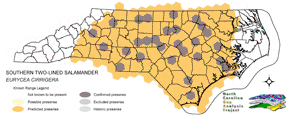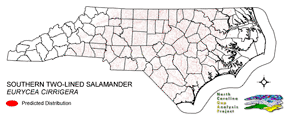
| Taxa: |
| Order: |
| Family: |
| Amphibia |
| Caudata |
| Plethodontidae |
| NatureServe Global Rank: |
| NatureServe State (NC) Rank: |
| G5 |
| S5 |
| Federal Status: |
| NC State Status: |
| --- |
| --- |


| Land Unit |
| US Fish & Wildlife Service |
| US Forest Service |
| US National Park Service |
| US Department of Defense |
| NC State Parks |
| NC University System |
| NC Wildlife Res. Com. |
| NC Forest Service |
| NC Div. of Coastal Mgmt. |
| Local Governments |
| Non-Governmental Org. |
| Other Public Lands |
| Private Lands |
| GAP Status 1-2 |
| All Protected Lands |
| Statewide |
| Hectares |
| 1,093.77 |
| 2,315.97 |
| 6,473.79 |
| 6.48 |
| 2,102.04 |
| 477.18 |
| 5,804.91 |
| 417.69 |
| 0.00 |
| 773.37 |
| 1,354.68 |
| 208.98 |
| 481,877.37 |
| 8,394.57 |
| 19,275.21 |
| 502,906.23 |
| Acres |
| 2,702.76 |
| 5,722.89 |
| 15,997.08 |
| 16.01 |
| 5,194.25 |
| 1,179.14 |
| 14,344.24 |
| 1,032.13 |
| 0.00 |
| 1,911.04 |
| 3,347.49 |
| 516.40 |
| 1,190,744.68 |
| 20,743.43 |
| 47,630.07 |
| 1,242,708.12 |
| % of Dist. on |
| Prot. Lands |
| 5.7 % |
| 12.0 % |
| 25.5 % |
| < 0.1 % |
| 10.9 % |
| 2.5 % |
| 29.6 % |
| 2.2 % |
| 0.0 % |
| 6.9 % |
| 6.9 % |
| 0.8 % |
| 0.0 % |
| 43.6 % |
| ----- |
| ----- |
| % of Dist. on |
| All Lands |
| 0.2 % |
| 0.5 % |
| 1.3 % |
| < 0.1 % |
| 0.4 % |
| < 0.1 % |
| 1.2 % |
| < 0.1 % |
| 0.0 % |
| 0.2 % |
| 0.3 % |
| < 0.1 % |
| 95.8 % |
| 1.7 % |
| ----- |
| ----- |
|
Occurring in the piedmont and coastal plain of North Carolina, this species is common to uncommon throughout its range (Martof et al. 1980, Wilson 1995). It is replaced by a congener, the Blue Ridge two-lined salamander, in the southern Appalachian mountains (Petranka 1998). Southern two-lined salamanders are associated with permanent small flowing waters such as seeps, springs, and stream corridors in hardwood forests of both uplands and bottomlands (Wilson 1995). Larger water bodies of floodplain ponds and bottomland swamps are also used. It seeks refuge under leaves, rocks, or logs in the vicinity of creeks or swamps (Wilson 1995). NATURE SERVE GLOBAL HABITAT COMMENTS: Rocky brooks, springs, seepages, river swamps (e.g., tupelo-cypress), forested floodplains with stagnant pools; may disperse into wooded terrestrial habitats in wet warm weather. Adults hide under objects in or near flowing water. Often found crossing roads in rainy weather during breeding season. Eggs are laid on/under submerged rocks, logs, or aquatic plants. |
| Code | Name | Description | NC Natural Heritage Program Equivalent |
| 380 | Coastal Plain Fresh Water Emergent | Emergent vegetation in fresh water seepage bogs, ponds and riverbeds of the coastal plain. Includes alliances dominated by sedges, eelgrass, as well as cane found in unforested cane-brakes. | Small Depression Pond, Sandhill Seep, Floodplain Pool, Unforested Floodplain Canebrake, Riverscour Prairies, Vernal Pools |
| 173 | Coastal Plain Riverbank Shrubs | Shrub dominated riverbanks, commonly dominated by willows and/or alders. | Sand and Mud Bar |
| 50 | Coastal Plain Mixed Bottomland Forests | Includes forests dominated by a variety of hardwood species, including sweetgum, cottonwood, red maple. | Coastal Plain Bottomland Hardwood (in part), Coastal Plain Levee Forest |
| 49 | Coastal Plain Oak Bottomland Forest | Bottomland forests dominated by deciduous oak alliances. Oaks represented can include swamp chestnut, cherrybark, willow, and/or overcup oak. Inclusions of loblolly pine temporarily flooded forests occur in patches. Hydrology is temporarily to seasonally flooded. | Coastal Plain Bottomland Hardwoods (in part) blackwater subtype, brownwater subtype |
| 158 | Coastal Plain Nonriverine Wet Flat Forests | Loblolly pine - Atlantic white-cedar - red maple - swamp tupelo saturated forests as well as forests dominated by loblolly, sweetgum, and red maple in non-riverine flats. | Non-riverine Wet Hardwood Forest |
| 41 | Peatland Atlantic White-Cedar Forest | Dense stands of Atlantic white cedar with saturated hydrology. Can include swamp tupelo, red maple, and pond pines with a moderate shrub and herb layer. | Peatland Atlantic White-Cedar Forest |
| 15 | Seepage and Streamhead Swamps | Includes extensive peat flats in the coastal plain, dominated by swamp tupelo, maples, and Atlantic white cedar alliances. In the sandhills includes streamhead pond pine and bay forests alliances. Saturated hydrology. | Bay Forest, Small Depression Pocosin, Streamhead Atlantic White Cedar Forest, Streamhead Pocosins |
| 30 | Cypress-Gum Floodplain Forests | Swamps dominated by black or swamp tupelo with or without Taxodium. Seasonally to semi-permanently flooded hydrology. | Cypress-Gum Swamps |
| 78 | Pond-Cypress - Gum Swamps, Savannas and Lakeshores | Cypress dominated swamps and lakeshores. Can include bays dominated by pond cypress or shorelines of coastal plain lakes with a narrow band of cypress. | Non-riverine Swamp Forest, Natural Lakeshores (in part) |
| 385 | Oak Bottomland Forest and Swamp Forest | The swamp chestnut oak, cherrybark oak, shumard oak and sweetgum alliance is one representative. Other alliances are dominated by water, willow, and overcup oaks. Swamp forests can be dominated by sweetgum, red maple, and black gum being dominant. Loblolly can occur in combination with sweetgum and red maple, or with tulip poplar. Includes saturated and semi- to permanently flooded forests in the mountains. | Piedmont/Mountain Bottomland Forest, Piedmont/Mountain Swamp Forest |
| 63 | Coastal Plain Mesic Hardwood Forests | Beech dominated forests with white oak and northern red oak as possible co-dominants. Dry-mesic to mesic forests on slopes and small stream bottoms in the coastal plain. | Mesic Mixed Hardwood Forest, Basic Mesic Forests |
| 238 | Piedmont/Mountain Submerged Aquatic Vegetation | Seasonally to permanently flooded areas with aquatic vegetation. Waterlily, pondweed, hydrilla smartweed are a few of the species that can occur. | Piedmont/Mountain Semipermanent Impoundment (in part) |
| 239 | Piedmont/Mountain Emergent Vegetation | Emergent vegetation of all wetland hydrologies. Sites would commonly support species such as tussock sedge, rushs, and cattail alliances. | Rocky Bar and Shore (in part) |
| 267 | Riverbank Shrublands | Riverside shrubs with temporarily flooded hydrologies. Found in the both the Mountains and Piedmont. Containing dominants such as smooth alder and a Carolina or black willows. | Sand and Mud Bar |
| 269 | Floodplain Wet Shrublands | Saturated shrublands of the Piedmont, includes buttonbush, swamp-loosestrife, decodon and alders. | Piedmont/mountain Semipermanent Impoundment |
| 230 | Piedmont Mesic Forest | American Beech - Red Oak - White Oak Forests. | Mesic Mixed Hardwood |
| 384 | Piedmont/Mountain Mixed Bottomland Hardwood Forests | Includes temporarily to seasonally forests dominated by hardwood species. Hardwoods include sweetgum, red maple, sycamore which co-occur in a mosaic of bottomland and levee positions. Includes alluvial hardwood forests in the mountains. Hemlock and white pine may occur as inclusions, but are generally mapped separately. | Piedmont/Mountain Alluvial Forest, Piedmont/Mountain Levee Forest |
| 383 | Piedmont Mixed Successional Forest | Generally loblolly mixed with successional hardwoods. Sweetgum, tulip poplar and red maple are common co-dominants in these successional forests. | No equivalent |
| 8 | Open water | Open water without aquatic vegetation. | No equivalent |
|
Mittleman, M. B. 1966. EURYCEA BISLINEATA. Cat. Am. Amph. Rep. 45.1-45.4.
Wilson, L. A. 1995. The Land Manager's Guide to the amphibians and reptiles of the South. Chapel Hill, NC: The Nature Conservancy. Petranka, J. W. 1998. Salamanders of the United States and Canada. Washington DC: Smithsonian Inst. Press. Barbour, R. W. 1971. Amphibians and reptiles of Kentucky. Univ. Press of Kentucky, Lexington. x + 334 pp. Minton, S. A., Jr. 1972. Amphibians and reptiles of Indiana. Indiana Academy Science Monographs 3. v + 346 pp. Mount, R. H. 1975. The Reptiles and Amphibians of Alabama. Auburn University Agricultural Experiment Station, Auburn, Alabama. vii + 347 pp. Behler, J. L., and F. W. King. 1979. The Audubon Society field guide to North American reptiles and amphibians. Alfred A. Knopf, New York. 719 pp. Martof, B. S., W. M. Palmer, J. R. Bailey, and J. R. Harrison, III. 1980. Amphibians and reptiles of the Carolinas and Virginia. University of North Carolina Press, Chapel Hill, North Carolina. 264 pp. Guttman, S. I., and A. A. Karlin. 1986. Hybridization of cryptic species of two-lined salamanders (EURYCEA BISLINEATAcomplex). Copeia 1986:96-108. Jacobs, J. F. 1987. A preliminary investigation of geographic genetic variation and systematics of the two-lined salamander, EURYCEA BISLINEATA (Green). Herpetologica 43:423-446. |
For more information please contact them at:
NC-GAP Analysis Project
Dept. of Zoology, NCSU
Campus Box 7617
Raleigh, NC 27695-7617
(919) 513-2853
www.basic.ncsu.edu/ncgap